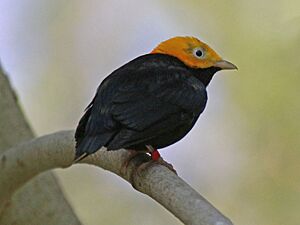Golden-headed manakin facts for kids
Quick facts for kids Golden-headed manakin |
|
|---|---|
 |
|
| Adult male | |
| Conservation status | |
| Scientific classification | |
| Genus: |
Ceratopipra
|
| Species: |
erythrocephala
|
 |
|
| Synonyms | |
|
|
The golden-headed manakin (Ceratopipra erythrocephala) is a small, bright bird. It lives in tropical forests in Central and South America. These birds are found in both wet and dry forests. They also live in areas where new trees are growing and in plantations.
This manakin is about 9.4 centimeters (3.7 inches) long. Male birds are mostly black with a shiny golden head. They have a yellow beak, white and red on their thighs, and pink legs. Female birds and young birds are olive-green with pink legs. When it's time to find a mate, male manakins do a special dance. They jump, slide, and dart between tree branches. This bird is quite common, and its numbers are stable. Because of this, experts say it is a "least concern" species.
What Does the Golden-Headed Manakin Look Like?
Like other manakins, this bird is small and colorful. It is usually about 9.4 centimeters (3.7 inches) long. It weighs around 12.5 grams (0.44 ounces).
The adult male is mostly black. But it has a bright golden cap on its head. Its thighs are white and red, and its legs are pink. It also has a yellowish beak.
Female birds and young males look different. They are olive-green. They look a bit like female white-bearded manakins. However, golden-headed manakins are smaller. They also have shorter tails and pinkish legs, not bright orange ones.
Besides a special buzzing song, these birds make other sounds. One common call is a buzzing pir pir prrrrrt.
Where Do Golden-Headed Manakins Live?
You can find the golden-headed manakin in many places. It lives in Panama, Colombia, and Trinidad. Its range goes south and east into the Guianas and Brazil. You can also find it in northern Peru. However, it does not live south of the Amazon or Ucayali Rivers.
This bird is common in forests. It also lives in areas where trees are regrowing after being cut down. You might also see them in plantations. They usually live below 1,100 meters (3,600 feet) above sea level. But sometimes, they can be found as high as 1,500 meters (5,000 feet).
Like other manakins, they eat mostly fruit. They also eat some insects and spiders.
Golden-Headed Manakin Courtship Display
Male golden-headed manakins perform an amazing dance to attract females. They gather in a special area called a lek. Each male chooses a horizontal branch, usually 6 to 12 meters (20 to 40 feet) high.
During their display, they quickly jump, slide, or dart to other branches. As they move, their wings make a whirring sound. They also make a buzzing zit-zit call. Sometimes, groups of up to 12 birds will perform together.
The female bird builds a shallow, cup-shaped nest. She places it low in a tree. She lays two yellowish eggs with brown spots. The female sits on the eggs for about 16 to 17 days until they hatch.
This bird lives in a very large area. Because of its wide range and stable numbers, experts consider it a "least concern" species. This means it is not currently at risk of disappearing.



